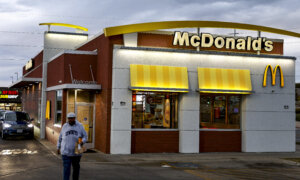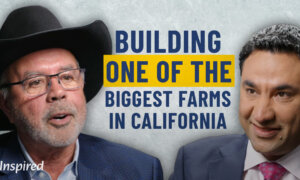The U.S. annual inflation rate came in below economists’ expectations as broad-based price pressures continue stabilizing across the economy.
According to the Bureau of Labor Statistics, the consumer price index (CPI) slowed to 2.5 percent in August, down from 2.9 percent. The consensus estimate was 2.6 percent.
Monthly inflation rose by 0.2 percent, unchanged from July and in line with market forecasts.
Core inflation, which removes the volatile energy and food categories, held steady at 3.2 percent, matching economists’ projections. The core CPI jumped at a higher-than-expected pace of 0.3 percent, up from 0.2 percent in the previous month.
Services inflation was unchanged at 4.9 percent.
Since January 2021, cumulative inflation has surged by 20 percent.
Greg McBride, chief financial analyst at Bankrate, says the cumulative inflation effect is still affecting households.
“Households know all too well the difference between ‘moderating inflation’ and ‘high prices.’ A lower rate of inflation just means prices aren’t going up as fast as they had, not that prices are coming down in any broad way,” he said in a statement. “Even a more customary pace of inflation doesn’t erase the rapid run-up in prices that has stretched household budgets, a strain millions of Americans are still feeling.”
Food inflation was little changed last month, though many items within the category showed month-over-month gains, such as eggs (4.8 percent), chicken (0.7 percent), beef and veal (0.3 percent), fresh fruits (0.7 percent), and milk (0.6 percent).
The energy index tumbled by 0.8 percent from July to August and eased to negative 4 percent in the 12 months ending August.
Despite a mid-summer rally, U.S. crude oil prices have been trending downward, sliding by more than 16 percent over the past month to around $66 per barrel.
Many factors, such as global demand growth concerns and easing tensions in the Middle East, have recently fueled the oil price crash.
This has helped mitigate the pain at the pump. According to the American Automobile Association, the national average price of gasoline is $3.26 per gallon, down by roughly 15 percent from the same time a year ago.
Shelter costs advanced by 0.4 percent and were up by 4.9 percent from the same time a year ago.
Rent of shelter and owners’ equivalent rent of primary residence each surged by 0.5 percent.
Shelter inflation has been sticky and stubborn, accounting for a significant portion of the monthly increase in the CPI. Economists have been projecting a slowdown in rent increases for nearly two years, but these forecasts have yet to come to fruition.
However, it is unclear if housing costs will diminish heading into 2025 because the federal statistics agency collects rent data every six months, meaning there is a lag in the data.
In July, economists at the Federal Reserve Bank of Minneapolis projected that shelter inflation will be 4.8 year over year in December and will remain above pre-pandemic levels throughout 2025.
“The behavior of shelter inflation provides a window into one source of these lags. Even if monetary policy were to affect market rents instantaneously, the rents measured in the CPI would only gradually reflect these market conditions,” the staff economists wrote in a paper. “In the current context, market rent growth normalized more than a year ago. Yet we are still waiting for the effects to fully materialize in standard measures of inflation.”
The New York Fed’s August Survey of Consumer Expectations suggests that Americans anticipate inflation to remain above the central bank’s 2 percent target rate over the next year.
Other notable year-over-year findings in the CPI report were motor vehicle insurance (16.5 percent), transportation services (7.9 percent), pet services including veterinary (6 percent), and hospital services (5.8 percent).
Looking ahead to next month’s CPI report, the Federal Reserve Bank of Cleveland’s Inflation Nowcasting model anticipates a reading of 2.3 percent. Core CPI is expected to be 3.1 percent.
Producer prices are the next key inflation measurement. The producer price index—a metric of prices paid for goods and services by businesses—is predicted to register little month-over-month growth.
Market Reaction
U.S. stocks were in the red after the CPI report in pre-market trading.Treasury yields were up across the board, with the benchmark 10-year yield rising above 3.68 percent. The 2- and 30-year yields climbed to 3.69 percent and 3.99 percent, respectively.
The U.S. dollar index, a gauge of the greenback against a basket of currencies, erased its early morning losses and returned to above the 101.6 threshold.
This was the final CPI report ahead of the widely anticipated Federal Open Market Committee policy meeting.
According to the CME FedWatch Tool, the futures market is betting on a quarter-point rate cut to kick off the central bank’s easing cycle.
In his keynote speech at the Jackson Hole Economic Symposium, Fed Chair Jerome Powell indicated that the institution was ready to shift monetary policy.
“The time has come for policy to adjust,” Powell said. “The direction of travel is clear, and the timing and pace of rate cuts will depend on incoming data, the evolving outlook, and the balance of risks.”
This would represent the first interest rate cut since the onset of the coronavirus pandemic. Since March 2022, the Fed has engaged in a quantitative tightening campaign, a blend of higher interest rates and balance sheet reduction. The benchmark federal funds rate was raised to a 23-year high of between 5.25 percent and 5.5 percent.
While the markets are pricing in nearly 240 basis points of rate cuts over the next 12 months, strategists at Saxo Bank do not anticipate “aggressive” rate-cutting by the Fed because of slowing supercore inflation and steady economic growth.
“Despite declines in most inflation components since the 2022 peak, ‘Supercore’ inflation (which measures the least volatile items in the inflation basket) remains persistently high at around 4.5%, but is also beginning to trend lower,” they wrote in a note. “Additionally, economic growth continues at trend levels, suggesting that an aggressive rate-cutting cycle may not be feasible.”
Supercore inflation is a gauge measuring services inflation excluding energy, food, and housing. After two consecutive months of a modest pullback—the first time since summer 2021—this preferred inflation metric rose by a soft 0.2 percent in the July CPI report and 0.3 percent in the August inflation data.
The next two-day Fed policy meeting is scheduled for Sept. 17–18.














